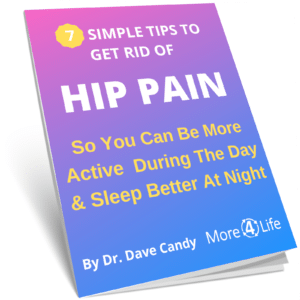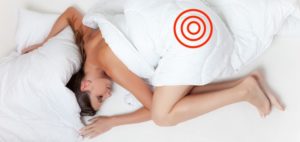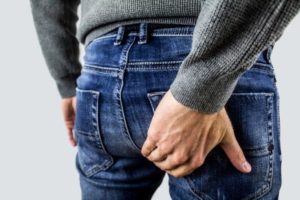Do You Suffer From Hip Pain or Hip Bursitis?
Hip Pain and Hip Bursitis can cause trouble sleeping, sitting, getting up from a chair, walking, and other daily activities.
Watch the video below to learn how we help people with hip pain and hip bursitis and get back to the things they love to do.
What Causes Hip Pain & Hip Bursitis?
Different Types of Hip Pain
People often use the term "hip pain" to refer to a number of different conditions including pain located in the groin, outside of the hip, or the buttock. Not all hip pain is created equally though, and thus each requires a different approach. The information below will help you learn a little more about each type of hip pain as well as what you can do to relieve hip pain.

Hip Joint / Groin Pain
The actual hip joint is located close to the groin, and so problems with the hip joint itself such as arthritis or labral tears usually present as groin pain. Hip Arthritis is a common problem when people age, and if you're past the age of 50 and have a hip xray, chances are that there's going to be some arthritis on your xray.
Don't let that scare you though.
Many people over 50 without any hip pain at all have hip arthritis on their xray. Hip arthritis does not have to hurt!
Similarly other "abnormal" findings you may read about such as labral tears or femoroacetabular impingement are quite common in people without hip pain as well. In fact, a 2012 Study in the American Journal of Sports Medicine showed that 73% of people without hip pain had "abnormal" MRI findings, with about 69% of those people having labral tears.
Simply put, just because your MRI isn't normal, you don't have to have pain.
Your Muscles Can Cause Hip Pain Too
Not all groin pain is caused joint problems though. Muscles in the lower abdomen or inner thigh can also cause groin pain. Some common muscle groups that can cause groin pain are the hip adductors, hip flexors (iliopsoas / recuts femoris), or the rectus abdominis. A careful clinical exam can help you determine the cause of your hip pain, and what can be done to help it.
Need Some Help For Your Hip or Groin Pain?
Click the button below to talk to our Hip Pain Specialist on the phone
Pain On The Outside of the Hip: Is It Hip Bursitis?

Many of the hip muscles attach to the greater trochanter. The greater trochanter sticks out wider than the rest of the bony structures in the area, and moreso in women due to their wider pelvis. As a result, this bone can rub on some of the soft tissue structures that run over it (tendons, bursa, IT band) and and cause them to become irritable. This can cause hip pain when laying on your side or hip pain when walking.
"Hip Bursitis" or "Trochanteric Bursitis" are commonly used terms to describe pain on the outside of the hip. This literally means "inflammation of the bursa (fluid-filled sac) that is over the greater trochanter", but realize that inflammation is often not present in this type of hip pain nor is the bursa always the structure that's causing the hip pain.
Cortisone injections in the hip are a traditional treatment for this type of hip pain and usually results in one of the following responses: 1) a very dramatic improvement in hip pain, or 2) no change in symptoms, or 3) the pain gets worse. This may be due to the presence or absence of inflammation as cortisone is a strong anti-inflammatory. It may also be an effect of where the needle is placed.
Just putting a needle without medication, referred to as Dry Needling , can have a pain relieving effect similar to that of an injection. With or without the medication though, the relief from either of these types of treatments is only temporary, unless the root cause of the hip pain or or hip bursitis is addressed.
That's what we do here at More 4 Life. We help people find the root cause of their hip pain so that they can get lasting relief!
Want To Get Lasting Relief From Hip Pain & Hip Bursitis?
Request a FREE Discovery Visit with our specialist to find the root cause of your hip pain, and what can be done to relieve it.
Buttock Pain / Sciatica

Hip Pain & Hip Bursitis Can Limit Daily Function
Regardless of which of the types of hip pain mentioned above that you have, hip pain of any variety can limit daily functions. Below are some tips on how you can relieve hip pain and hip bursitis during some common daily activities:
- Hip Pain When Sleeping
- Hip Pain When Getting Up From A Chair
- Hip Pain When Walking
Hip Pain / Hip Bursitis When Sleeping
Use These Tips To Relieve Hip Pain When Sleeping
- When laying on your back, bend your knees up and put a pillow under your knees. This puts your lower back in a more neutral alignment and helps take stress off of the joints in the back. It also relieves some pressure off of the low back nerves by opening up the spaces in your back where the nerves comes out (the neuroforamina). This can prevent pain from being referred from your back into your buttocks, hips, or knees at night while sleeping.
- When sleeping on your side, put a pillow between your knees bring your knees closer to your chest like a fetal position. Bringing your knees closer to your chest helps unload the joints of the spine as well as opens up the spaces in your back where the nerves comes out. Putting the pillow between your knees helps keep your top leg from drooping over at night while sleeping, which causes your back to twist and puts stress on your hip and knee joints. Keeping your back, hips, and knees in a good alignment at night while will help you to sleep better and wake up feeling more refreshed and less painful the next morning.
- Avoid sleeping on your stomach if at all possible. Sleeping on your stomach puts a lot of arch in your lower back and can irritate the joints and nerves in the back if you already have back pain. If you MUST sleep on your stomach though, put a pillow under your belly to take some of the arch out of your low back.
Use These Tips To Learn How To Get Up From A Chair Without Hip Pain
Standing Up From A Chair Without Hip Pain
- Scoot to the front edge of the chair.
- Bend your knees to get your feet underneath of you.
- Lean forward to bring your center of gravity over your feet. Your hips should almost naturally starts to rise up as your head goes forward.
- Straighten your knees and allow your hips to roll under you keeping your back slightly rounded.
- When you get all the way upright, don't lean backward. Even if it feels like you’re still bend over, you’re probably not... that's just the position that your body has gotten used to as "normal".
Sitting down is actually just the opposite:
- Lean your trunk forward and push your hips backward reaching back for the chair.
- Allow your knees to bend
- When your bottom hits the seat, THEN raise your trunk back upward, hinging from the hips.
- Scoot to the BACK of the chair so that your back can rest comfortably against the backrest. See our last post "This Is A Chair! Do You Know How To Use It?" for more advice on sitting posture so that you can sit without back pain or hip pain.
Hip Pain When Walking
Hip joint pain can also cause pain in the the groin and/or inner thigh during other weight-bearing activities such as walking, especially if you've been walking for a long time. Hip arthritis, labral tears, hip impingement, and hip bursitis can all cause hip pain when walking. Weakness of the hip muscles can also cause hip pain when walking. We'll discuss more about weakness of the hip muscles in just a minute. However, often just making a few small changes to the way that you walk can help you relieve hip pain when walking.
Use These Tips To Learn How To Walk Longer Without Hip Pain
- Start out in a neutral standing position. Roll your pelvis underneath of you. It may feel like you're slouched forward, and that's OK.... you're probably not, you'll just feel like you are. This is important because a lot of times hip pain when standing and walking can be referred from you low back, especially if you have back pain as well as hip pain.
- Lean forward so that it feels like you're going to fall forward if you don't take a step. Walking is basically an act of controlled falling, over and over again. Keep your chest and shoulders in front of your feet, and keep taking steps so that your feet are always catching up with your trunk. This keeps your weight going forward in the direction you are walking.
- Hit on the middle portion of your foot rather than heel striking. When you hit on your heel, your bodyweight is behind you. It also causes a lot more force to get sent up your legs to your knees, hips, or back. When strike on the midfoot, it helps absorb shock better and can help you prevent knee pain, hip pain, and back pain.
- If you have hip bursitis or pain on the outside of your hip, squeezing your buttock muscles as you hit your foot on the ground (on the side that hurts), can also help you avoid hip pain when walking.
Keep in mind that walking is highly individualized based on your body and where specifically you are having pain. If you need some help relieving hip pain when walking, click here to request a FREE Discovery Visit, where we can evaluate your walking and let you knew what can be done to help you relieve your hip pain.
Weakness In The Hip Muscles Can Contribute To Hip Pain Hip Pain / Hip Bursitis
If there's also weakness in the hip muscles or gluteal muscles, this can put additional pressure on the hip joint and labrum. It can also cause the hip muscles to get stretched over the outside of the hip causing bursitis or other pain on the outside of the hip. You can Google "exercises to strengthen weak hip muscles" and you'll find tons of results. The problem is, when people find exercises on Google, they often do them wrong. One common example of this is called the "Clam" or "Clamshell" exercise. This is one of the most common exercises for weak hip muscles, but most people do it incorrectly, even if they've been taught to do it by a personal trainer, physical therapist, or other healthcare professional. Click here to learn how to do the clamshell exercise for weak hip muscles properly.
In most cases though, no matter how many sets and repetitions of clamshells, or other hip exercises that you do, the hip pain probably isn't going to get better for good until you find out the root cause of the hip pain and address that problem. If you need some help to find the root cause of your hip bursitis or other hip pain, we're happy to help! Use the links below to choose how you prefer to get started.
Need Some Help For Hip Pain or Hip Bursitis?
Choose which option works best for you...


